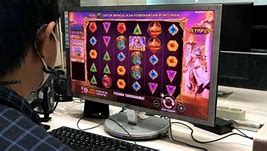
Win and withdrawal limits, payment options
Ratu Judi Casino accepts deposits via 9 payment methods. This includes: Bank Rakyat Indonesia (BRI), CIMB Bank, GoPay, Bank Mandiri, OVO, Bank Danamon, Bank Central Asia (BCA), DANA, Bank Negara Indonesia (BNI).
Many online gambling sites place restrictions on the maximum winnings and withdrawal amounts for players. Oftentimes, the win and withdrawal limits are high enough as to not impact most players. That being said, there are casinos, which pose quite restrictive limitations on the win and withdrawal amounts. This is the reason why we consider these limitations in our casino reviews. You can find information about the casino's win and withdrawal limits in the table below.
Note: It is likely that not all of the payment methods listed above are suitable for both deposits and withdrawals. Furthermore, certain payment options may only be available in specific countries.
Player complaints about Ratu Judi Casino
Player complaints play an important part in our casino review methodology, as they give us a clear insight into issues experienced by players and casinos’ way of handling them. We take into account all complaints filed via our Complaint Resolution Center in addition to those we compile from other sources when examining each casino's safety and fairness.
We have found no relevant complaints about this casino.
Ratu Judi Casino company data and licenses
Ratu Judi Casino has estimated annual revenues higher than $1,000,000. This establishes it as one of the smaller online casinos within the bounds of our categorization.
As far as we know, Ratu Judi Casino does not have a gambling license.
Ratu Judi Casino Terms and Conditions
When evaluating online casinos, we meticulously analyze each casino's Terms and Conditions with the aim to assess their fairness level. In T&Cs of many casinos, we come across certain clauses, which we perceive as unjust or overtly predatory. In some cases, these give the casino the possibility to justify withholding player winnings.
We did not find any unfair or predatory rules in the Terms and Conditions of Ratu Judi Casino during our review.
This review examines Ratu Judi Casino, using our casino review methodology to determine its advantages and disadvantages by our independent team of expert casino reviewers. By evaluating the casino's licenses, Terms and Conditions, up-to-date player complaints, limits, customer support, and other key elements, our review team has classified the level of safety and fairness of the casino, categorizing it as either legit and safe, a possible scam, or falling in between.
The casino's Safety Index, a score indicating the safety and fairness of online casinos, has been determined through our analysis of these findings. A higher Safety Index decreases the probability of experiencing issues when playing or making a withdrawal. Ratu Judi Casino scored a Below average Safety Index of 6.4, which makes it a suboptimal option for most players in terms of fairness and safety. Read our Ratu Judi Casino review to discover more about this casino and decide whether it is a suitable option for you.
Ratu Judi Casino user feedback and reviews
On Casino Guru, users can rate and review online casinos to voice their opinions, feedback, or experience. Based on these, we generate a total user feedback that varies between Terrible and Excellent.
Sadly, our database currently has no user reviews for Ratu Judi Casino. You have the opportunity to be the first to evaluate and rate this casino on our website, regardless of whether your experience was positive or negative.
Note: It's important to note that user reviews may not always provide an objective reflection of the casino's quality. Instances exist where casinos write fake reviews to boost their user feedback score, while some dissatisfied players leave multiple negative reviews to tarnish the casino's reputation. Our best efforts are put into filtering these out and calculating an objectively accurate user feedback score; nonetheless, we do not include user feedback in our Safety Index calculation.
Fairness and safety of Ratu Judi Casino
We calculate a casino's Safety Index based on an elaborate formula that takes into consideration a wide range of information that we have collected and assessed in our review. These involve the casino's estimated revenues, complaints from the players, T&Cs, blacklists, and so on.
In our review of Ratu Judi Casino, we meticulously evaluated and analyzed the Terms and Conditions of Ratu Judi Casino. To our knowledge, there are no rules or clauses that could be considered unfair or predatory. This is a great sign, as any such rules could potentially be used against players to justify not paying out winnings to them.
Based upon our estimates and collected information, we consider Ratu Judi Casino one of smaller online casinos . Considering its size, this casino has a very low sum of disputed winnings in complaints from players (or it has not received any complaints whatsoever). We consider both the casino's size and the number of player complaints and how they correlate, seeing as bigger casinos tend to receive more complaints due to the larger number of players.
As far as we know, no relevant casino blacklists include Ratu Judi Casino. If a casino is included on a blacklist such as our Casino Guru blacklist, this could hint that the casino has committed some kind of misconduct towards its customers. We urge players to keep this in mind when searching for an online casino to play at.
Taking into account all factors in our review, Ratu Judi Casino has scored a Safety Index of 6.4, representing a Below average value. For players seeking an online casino that prioritizes fairness in the online gambling experience they offer, this casino is not a good fit.
Ratu Judi Casino bonuses and promo codes
Online casinos give bonuses to both new and existing players in order to gain new customers and encourage them to play. There is currently 1 bonus from Ratu Judi Casino in our database, listed in the 'Bonuses' section of this page.
Austronesian honorific title for male Fijians of chiefly rank
Ratu ([ˈrɑːtu]) is an Austronesian title used by male Fijians of chiefly rank. An equivalent title, adi (pronounced [ˈandi]), is used by females of chiefly rank. In the Malay language, the title ratu is also the traditional honorific title to refer to the ruling king or queen in Javanese culture (though it has since been used in modern contexts to refer to both queen regnant and queen consort of any nation, e.g. "Ratu Elizabeth II" and "Ratu Camilla"). Thus in Java, a royal palace is called "keraton", constructed from the circumfix ke- -an and Ratu, to describe the residence of the ratu.
Ratu: A chiefly title for men used alone as a form of address, or in front of the chief's name, only in certain places The source of the Fijian title is Verata, and it has spread throughout Fiji during the past century, now applied to many local, minor chiefs as well as the major ones. The concept of his type of title is from Tonga. Strictly speaking, the title belongs only in Verata. In their time, Cakobau or Tanoa, his father, never themselves used the title of Ratu. It does not appear with Cakobau's name or any other chief's name in the Deed of Cession of 1874. (Exceptionally, in the 1850s, Ratu Mara Kapaiwai was one of the few who did use the word Ratu, though that may have been a name rather than a title.) It has been affixed to the names of Tana and Cakobau by later Fijians, retroactively. The Cakobau Memorial Church on Bau Island is now referred to as the Ratu Cakobau Church. Ratu may also be used as a personal first name or second name. The title may be acquired as part of a chiefly name, by a namesake. In such cases, it does not imply chiefly status. Adi is the female equivalent, sometimes heard as Yadi in Lau.
Ra is a prefix in many titles (ramasi, ramalo, rasau, ravunisa, ratu), and tu means simply "chief". The formal use of "ratu" as a title in a name (as in "Sir" in British tradition) was not introduced until after the cession of 1874. Until then, a chief would be known only by his birth name and his area-specific traditional title.
Regional variations include ro in Rewa and parts of Naitasiri and Tailevu, roko in parts of Naitasiri, Rewa and Lau (particularly the Moala group), ra in parts of Vanua Levu, particularly the province of Bua.
In all those places, it is used as a title preceding the person's name, much like "prince", "duke", "earl", "baron" or "lord".
The semantics, however, are a little different in Fijian although the name and title are usually reversed, for example:
In English, one would say His Royal Highness (Styling) Prince (address/title) Andrew (name), Duke of York (noble title).
In Fijian, one would say, Gone Turaga Na (Styling) Roko Tui Bau (noble title), Ratu (address/title) Joni Madraiwiwi (name).
The Fijian nobility consists of about seventy chiefs, each of whom descends from a family that has traditionally ruled a certain area. The chiefs are of differing rank, with some chiefs traditionally subordinate to other chiefs. The Vusaratu clan is regarded as the highest chiefly clan, with regards to the people of Bau until the rise of the Tui Kaba clan leader, who exiled all Vusaratu members. They are the heirs of Ratu Seru Epenisa Cakobau, the Vunivalu of Bau or Tui Levuka (Paramount Chief of Bau, on the eastern side of Viti Levu, Fiji's most populous island), He proclaimed himself "Tui Viti/King of Fiji" in 1871. (He was only recognised by the British and a few provinces of Viti Levu) He along with 12 high Chiefs subsequently ceded the islands to the United Kingdom in 1874.
Other prominent chiefly clans include the Vuanirewa (the traditional rulers of the Lau Islands) and the Ai So'ula (the traditional rulers of Vanua Levu).
During the colonial rule (1874–1970), the British kept Fiji's traditional chiefly structure and worked through it. They established what was to become the Great Council of Chiefs, originally an advisory body, but it grew into a powerful constitutional institution. Constitutionally, it functions as an electoral college to choose Fiji's president (a largely honorary position modelled on the British monarchy), the vice-president, and 14 of the 32 senators, members of Parliament's "upper house", which has a veto over most legislation. The 18 other senators are appointed by the Prime Minister (9), the Leader of the Opposition (8), and the Council of Rotuma (1); these appointees may, or may not, be of chiefly rank also. (The Senate was modelled on Britain's House of Lords, which consists of both hereditary and life peers.)
The presidency, vice-presidency, and fourteen senators are the only constitutional offices whose appointment is controlled by persons of chiefly rank. Chiefs in post-independence Fiji have always competed for parliamentary seats on an equal footing with commoners. In the years following independence, this favored the chiefly class, as the common people looked to them as their leaders and generally voted for them. For several elections, many ethnic Fijian members of the House, which is elected by universal suffrage, were of chiefly rank, but in recent elections, the discrepancy between chiefs and commoners is slowly narrowing, as commoners are becoming better educated and have begun to work their way into the power structure. The chiefs, however, retain enormous respect among the Fijian people. In times of crisis, such as the coups of 1987 and the third coup of 2000, the Great Council of Chiefs often stepped in to provide leadership when the modern political institutions have broken down.
Seperti ditulis pada artikel sebelumnya, Tafsir Jawa atas Kuasa dan Kekuasaan, pandangan kosmologi Jawa meyakini adanya kesejajaran antara makrokosmos (jagat gede) dan mikrokosmos (jagat cilik).
Menurut kepercayaan ini, keseluruhan tatanan sosial yang terdiri dari masyarakat luas di luar benteng kraton, para abdi dalem, dan lapisan kelompok para priyayi, serta berpuncak hirarkis pada diri raja, pada derajat tertentu merupakan representasi kosmis itu sendiri. Sekalipun dimaknai demikian, secara simultan tatanan sosial juga selalu berada di bawah pengaruh daya-daya kosmis alam semesta.
Dalam kerangka konsepsi Dewa-Raja atau Ratu-Binanthara inilah, kesanggupan seorang raja untuk mengharmoniskan keseluruhan tatanan sosial dan sekaligus daya-daya kosmis alam semesta, ialah kata kunci bisa atau tidaknya menghasilkan kemakmuran dan kesejahteraan bagi masyarakatnya.
Sedangkan bicara perihal daya-daya kosmis, selain didasarkan pada wahyu, daya kosmis lainnya ialah restu para leluhur tanah Jawa dan pusaka. Dalam konteks inilah, bicara restu leluhur tanah Jawa sudah tentu bukan hanya satu dan tunggal. Namun begitu, salah satu mitos yang diyakini kuat oleh masyarakat Jawa ialah Kanjeng Ratu Kidul.
Bagaimana menonjolnya mitos Kanjeng Ratu Kidul atau disingkat KRK, tanpa mengenal mitos ini orang tidak bakalan dapat memahami makna tarian sakral Bedhaya Ketawang; juga makna artefak bangunan Panggung Sanggabuawana di Kraton Surakarta; tak kecuali adanya folklore tentang jin bernama lampor maupun ritus sedekah laut yang lazim dilakukan masyarakat Jawa di sepanjang daerah pesisir Samudra Hindia.
Jejak-jejak Diskrusif
Merujuk artikel Robert Wessing yang berjudul “A Princess from Sunda: Some Aspects of Nyai Roro Kidul,” Asian Folklore Studies Vol. 56 tahun 1997, setidaknya ditemui beberapa versi sejarah. Menurut Wessing, sebagai seorang putri Sunda, umumnya KRK diceritakan sebagai puteri penguasa kerajaan Pajajaran di Jawa Barat, meskipun perihal siapa ayahnya ada beberapa nama mengemuka. Ada yang menyebutkan KRK ialah putri dari Prabu Mundingsari, lainnya menyebut nama Prabu Munding Wangi, atau juga disebut nama Prabu Siliwangi maupun Prabu Cakrabuwana.
Selain Pajajaran, cerita lain mengisahkan asal-usul KRK ialah kerajaan Galuh. Prabu Sindhula dari abad ke-13 merupakan ayahnya. Tempat asal lainnya yang disebutkan ialah kerajaan Kediri di Jawa Timur, saat diperintah oleh “Notradamus Jawa” yaitu yang legendaris, Raja Jayabaya; atau bahkan berasal dari kerajaan yang lebih tua, Kahuripan, diperintah oleh Raja Airlangga juga berlokasi di Jawa Timur. Namun demikian dari semua kisah itu, bagaimanapun kerajaan Pajajaran merupakan asal-usul KRK yang paling sering disebutkan.
Bagaimana kisah terjadinya transformasi dari seorang putri menjadi Dewi Samudra juga muncul banyak versi. Kisah paling umum menuturkan, dia adalah seorang puteri cantik yang, karena sihir ibu tirinya yang jahat dan cemburu, terjangkit penyakit kulit. Sakit kulit itu membawa bau yang menjijikkan sehingga memaksanya meninggalkan istana, dan pergi mencari perlindungan ke hutan. Beberapa kisah mengatakan, dibalut duka yang mendalam puteri itu lalu bermeditasi dan moksha.
Merujuk Poerbatjaraka dan Woodward, Wessing mencatat versi lain. Konon diceritakan, permaisuri raja Galuh melahirkan anak perempuan. Keanehan muncul, ia laiknya Yesus sejak usia bayi sudah dapat bicara dan berkata:
“Aku Ratu Ayu, akulah penguasa semua lelembut di Tanah Jawa. Istanaku berada di Laut Kidul.”
Raja Sidhula, yaitu raja Galuh yang telah lama meninggal, dikisahkan kemudian muncul memberi tanda dan bersabda bahwa puteri itu ialah cucunya. Untuk menjaga kesuciannya dia tidak akan pernah menikah hingga nanti tiba saatnya seorang raja Muslim muncul dan memerintah Jawa. Sosok inilah yang nanti jadi suaminya.
Menunggu dua abad lebih, hingga suatu saat datanglah Panembahan Senapati, pendiri wangsa Mataram-Islam. Historigrafi Jawa yaitu Babad Tanah Jawa meriwayatkan, bagaimana Panembahan Senopati mula pertama bertemu dengan KRK. Pertemuan yang bermuara menjadi hubungan percintaan ini mengawali kisah, di mana KRK bukan hanya menjadi “istri” Panembahan Senopati, melainkan juga raja-raja Mataram-Islam penerusnya.
Awalnya dikisahkan dia pergi bertapa di Sungai Opak (bahasa Jawa: kungkum), lalu berenang (tapa ngeli) ke arah muara hingga mencapai Pantai Selatan. Sampai di sana Panembahan Senapati meneruskan bertapa dan memohon petunjuk untuk memenangkan peperangan melawan Sultan Hadiwijaya di Pajang. Konon, berkat ketekunan bertapa membuat Samudera Hindia bergolak. Istana gaib tempat singgasana KRK menjadi porak-peranda karena kekuatan meditasi sang pemuda itu.
Walhasil, KRK pun muncul. Namun pucuk dicinta ulam tiba, KRK justru tertegun dan terpesona melihat seorang pemuda gagah tengah bermeditasi. Dia langsung jatuh hati dan bersimpuh di kaki Panembahan Senapati. Setelah bercinta tiga hari tiga malam di istana gaib Laut Selatan, KRK berjanji akan membantu Penembahan Senapati dan anak cucu keturunannya.
Menurut De Graaf, Ki Ageng Pemanahan tercatat meninggal di tahun 1583, dan sebagai gantinya ialah putranya Panembahan Senopati. Jika pembacaan De Graaf itu valid, menarik disimak pernyataan Sri Sultan Hamengkubuwono IX yang berkuasa pada 1940–1988, terhitung hampir berselang empat abad kemudian sejak Panembahan Senopati.
Dalam biografinya “Tahta untuk Rakyat” yang disusun oleh Atmakusumah (editor), ketika diwawancarai dan ditanya apakah benar dia adalah "suami" dari KRK dan apakah pernah "berhubungan" dengannya, Sultan Hamengku Buwono IX menjawab:
“Menurut kepercayaan lama memang demikianlah halnya. Saya menyebutnya Eyang Rara Kidul saja. Dan saya pernah mendapat kesempatan "melihatnya" setelah menjalani ketentuan yang berlaku seperti berpuasa selama beherapa hari dan sebagainya. Pada waktu bulan naik, Eyang Rara Kidul akan tampak sebagai gadis yang amat cantik; sebaliknya apabila bulan menurun, ia tampil sebagai wanita yang makin tua.”
Ketimbang “istri”, pada anak cucu penerus Panembahan Senapati setelah memasuki abad ke-20, posisi KRK tampaknya lebih berfungsi sebagai pepunden atau pamomong, atau sebutlah itu leluhur. Demikianlah catatan Jhon Pemberton dalam bukunya On The Subject of Java perihal cerita popular di Solo. Masyarakat Solo beranggapan raja sebagai “suami” KRK hanya sampai masa Paku Buwono IX.
Konon, diceritakan Paku Buwono X suatu ketika tengah naik ke Panggung Sanggabuwono. Tempat ini merupakan ruang pertemuan antara KRK dan Susuhunan. Di dalam bilik itu disediakan kursi dan pakaian serta sesaji untuk KRK. Diceritakan suatu saat PB X terpeleset saat menaiki tangga bangunan itu, dan KRK berucap kaget: “….Ooo, kepiye ngger!?” (Ooo, bagaimana kau nak!?). Nah, gara-gara dipanggil “ngger” itulah, Paku Buwono X tak pernah lagi dianggap sebagai “suami” KRK.
Pemberton juga memiliki catatan lain yang menarik. Paku Buwono yang memerintah pada 1823--1830, seperti diketahui dibuang ke Ambon oleh Pemerintah Hindia Belanda karena ketahuan mendukung pemberontakan Pangeran Diponegoro dalam Perang Jawa (1825--1830). Pemberton mencatat, salah satu alasan kuat Belanda untuk membuang Susuhunan ini dikarenakan dia diketahui sering “berkunjung dan menemui” KRT hingga mendapat tuduhan tengah merencanakan sebuah makar.
Menarik juga dicermati, sekalipun keberadaan KRK katakanlah lekat dengan sejarah wangsa Mataram-Islam, ritus sedekah laut bukan hanya dilakukan oleh institusi keraton. Melainkan, juga dilaksanakan oleh masyarakat yang tinggal di wilayah pesisir selatan Pulau Jawa. Ini artinya, masyarakat luas juga merasa memiliki KRK sebagai penguasa dan pelindung hidup mereka.
Itulah sebabnya pelbagai ritus terhadap KRK nisbi sering dilakukan oleh orang Jawa. Dari yang sifatnya pribadi hingga yang sifatnya kolektif atau massal. Pewaris Mataram-Islam, sebutlah Kasultanan di Yogyakarta, hingga kini setahun sekali masih melaksanakan upacara labuhan.
Kata labuhan berarti membuang barang-barang tertentu di laut atau kawah gunung sebagai sesaji. Barang yang dilabuh, antara lain, seperangkat pakaian untuk KRK. Pakaian dan kebutuhan wanita itu berupa kain panjang, semekan atau kain tutup dada, tusuk konde dan berbagai macam pakaian wanita beserta perlengkapan lain seperti param, ratus, minyak cendana, dan kepingan uang logam.
Bukan hanya ritus labuhan, kraton juga mengenal ritus sakral lain berupa pementasan Tari Bedhaya Ketawang. Menurut Kitab Wedhapradangga, pencipta tarian ini adalah Sultan Agung, raja paling agung yang berkuasa pada 1613--1645. Meskipun demikian kepercayaan tradisional meyakini, tarian ini diciptakan oleh KRK sendiri. Wajar saja, tarian ini bukan hanya semata sakral, tapi juga bahkan dianggap sebagai pusaka.
Menariknya, Sunan Kalijaga sebagai juru syiar Islam di tanah Jawa juga ikut memberikan patokan-patokan saat menciptakan titi nada gending tarian tersebut. Titi nada gamelan itu disebut diberi nama Gending Ketawang Gedhe berlaras pelog pathet 5.
Tari ini melukiskan proses jatuh cintanya KRK pada Panembahan Sanapati. Segala gerakannya melukiskan bujuk rayu dan cumbu birahi. Untuk itu KRT memohon Sinuhun tidak tergesa pulang, namun Sinuhun tidak mau. Dia masih ingin mencapai “sangkan paran dumadi”, yaitu hakikat kemanunggalan diri dengan Tuhan.
Namun Panembahan Senapati berkenan memperistri KRT, bahkan janji hingga turun-temurun. Siapa saja keturunannya yang bertahta di tanah Jawa akan mengikat janji dengan KRT pada detik kenaikan tahtanya (jumenengan nata). Karena itulah tarian sakral ini hanya ditarikan ketika pelantikan raja atau peringatan momen tersebut di setiap tahunnya.
Konon, saat tarian sakral ini ditarikan KRT selalu hadir dan turut menari di antara sembilan penari lainnya. Bahkan KRT jugalah yang konon mengajar secara langsung Tari Bedhaya Ketawang pada penari-penari kesayangan raja tersebut. (W-1)
Jalan Lintas Pantai Timur Sumatra (Way Kambas-Way Jepara), Labuhan Ratu (Lampung Timur), Lampung, Indonesia
Ratu Judi Casino slots and casino games
Ratu Judi Casino has these types of casino games on offer: Slots, Roulette, Blackjack, Betting, Video poker, Baccarat, Live games, Craps and dice, Other card games, Other games.
Games from 19 casino game providers are available. This includes Playtech, Apricot (Microgaming), Pragmatic Play, Red Tiger Gaming, Habanero, CQ9 Gaming, SBOBET, WM Casino, ION Casino, Global Gaming, SV388, Joker, KingMaker, Ameba Entertainment, Dream Gaming, Spadegaming, PGsoft (Pocket Games Soft), Awesome Entertainment (AE), JDB Gaming.
Customer support and language options
In our casino reviews, we always collect data about available languages and customer support options. In the table below, you can see an overview of language options at Ratu Judi Casino.
To understand how helpful, professional, and prompt the customer support representatives are, we contact them directly as a part of our casino review methodology. We find customer support important, since its purpose is to help you resolve any issues you might experience, such as registration at Ratu Judi Casino, account management, withdrawal process, etc. We would say Ratu Judi Casino has an average customer support based on the responses we have received during our testing.



